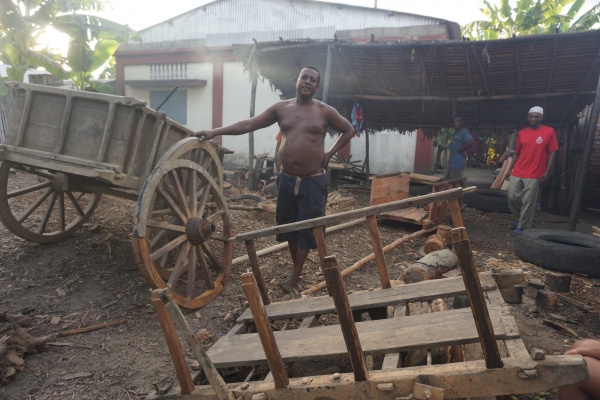Difference between revisions of "Zebu cart"
CampMaster (talk | contribs) (Tags: Mobile edit, Mobile web edit) |
CampMaster (talk | contribs) (Tags: Mobile edit, Mobile web edit) |
||
| (150 intermediate revisions by the same user not shown) | |||
| Line 1: | Line 1: | ||
| − | ''' | + | '''It's sunrise in Sambirano and a beautiful view from the bridge in Ambanja is unfolding. The valley towards the southeast and the island of Nosy Komba are visible in the distance to the northwest. A small traffic jam is forming on the narrow bridge, mostly made up of zebu carts rather than cars.''' |
| − | [[File: | + | {| class="imageTable" |
| + | |- | ||
| + | |colspan="3" | [[File:Zebu_cart_028.jpg|600px]] | ||
| + | |- | ||
| + | |[[File:Zebu_cart_032.jpg|196px]] | ||
| + | |align="center"|[[File:Zebu_cart_030.jpg|196px]] | ||
| + | |align="right"|[[File:Zebu_cart_024.jpg|196px]] | ||
| + | |- | ||
| + | |[[File:Ambanja_053.jpg|196px]] | ||
| + | |align="center"|[[File:Ambanja_055.jpg|196px]] | ||
| + | |align="right"|[[File:Ambanja_057.jpg|196px]] | ||
| + | |- | ||
| + | |} | ||
| − | + | The carts are filled with fresh crops brought in from the countryside by farmers who have been on the move since before dawn. They are heading into town to sell their goods at the fruits and vegetables markets. | |
| − | + | [[File:Zebu_cart_007.jpg|600px]] | |
| − | + | Zebu carts, Omby Sarety in Malagasy (''Aomby'' in northern dialect), are common sights in and around Ambanja and across the country. These zebu-led carts remain as practical and relevant among farmers today as they have since ancient times. | |
| − | + | [[File:Zebu_cart_067.jpg|600px]] | |
| − | + | Dozens of workshops produce carts in Ambanja. One of them is led by Mr Theodore, who, along with his team of six skilled carpenters, manually assembles around 50 carts per year without using motorised power tools. | |
| − | [[File: | + | {| class="imageTable" |
| + | |- | ||
| + | |colspan="3" | [[File:Zebu_cart_065.jpg|600px]] | ||
| + | |- | ||
| + | |[[File:Zebu_cart_052.jpg|196px]] | ||
| + | |align="center"|[[File:Zebu_cart_062.jpg|196px]] | ||
| + | |align="right"|[[File:Zebu_cart_063.jpg|196px]] | ||
| + | |- | ||
| + | |[[File:Zebu_cart_064.jpg|196px]] | ||
| + | |align="center"|[[File:Zebu_cart_069.jpg|196px]] | ||
| + | |align="right"|[[File:Zebu_cart_072.jpg|196px]] | ||
| + | |} | ||
| − | + | The design and model are always the same: A simple two-wheeler that easily attaches to one or more zebus. A cart takes about one week to build and costs 1,800,000 Ariary (about USD 400). | |
| − | [[File: | + | [[File:Zebu_cart_009.jpg|600px]] |
| − | [[File: | + | {| class="imageTable" |
| + | |- | ||
| + | |colspan="3" | [[File:Zebu_cart_053.jpg|600px]] | ||
| + | |- | ||
| + | |[[File:Zebu_cart_034.jpg|196px]] | ||
| + | |align="center"|[[File:Zebu_cart_047.jpg|196px]] | ||
| + | |align="right"|[[File:Zebu_cart_043.jpg|196px]] | ||
| + | |- | ||
| + | |} | ||
| − | [[File: | + | <HTML5video type="youtube">G3unvlw5cJQ</HTML5video> |
| + | |||
| + | {| class="imageTable" | ||
| + | |- | ||
| + | |colspan="3" | [[File:Zebu_cart_014.jpg|600px]] | ||
| + | |- | ||
| + | |[[File:Zebu_cart_037.jpg|196px]] | ||
| + | |align="center"|[[File:Zebu_cart_018.jpg|196px]] | ||
| + | |align="right"|[[File:Zebu_cart_010.jpg|196px]] | ||
| + | |- | ||
| + | |[[File:Zebu_cart_016.jpg|196px]] | ||
| + | |align="center"|[[File:Zebu_cart_019.jpg|196px]] | ||
| + | |align="right"|[[File:Zebu_cart_033.jpg|196px]] | ||
| + | |- | ||
| + | |[[File:Zebu_cart_013.jpg|196px]] | ||
| + | |align="center"|[[File:Zebu_cart_041.jpg|196px]] | ||
| + | |align="right"|[[File:Zebu_cart_038.jpg|196px]] | ||
| + | |- | ||
| + | |colspan="3" | [[File:Sambirano_078.jpg|600px]] | ||
| + | |- | ||
| + | |} | ||
| + | |||
| + | The many Malagasy farmers deserve credit for their traditional and eco-friendly transportation, which by avoiding the use of petrol and diesel-powered vehicles helps keep the air and environment clean and fresh. | ||
| + | |||
| + | <HTML5video type="youtube">bVOxTPRDySo</HTML5video> | ||
| + | |||
| + | Madagascar is a nation of mostly smallholder farmers. One goal of the original organic farming movement was to minimise the use of motorised farming tools, an aspect of agriculture in which Madagascar and its | ||
| + | innumerable farmers remain far ahead of every developed nation. | ||
| + | |||
| + | View more [[Zebu cart photos]] | ||
| + | |||
| + | == Additional information == | ||
| + | |||
| + | * Mr. Théodore: 032 49 341 77 | ||
Latest revision as of 12:03, 2 September 2024
It's sunrise in Sambirano and a beautiful view from the bridge in Ambanja is unfolding. The valley towards the southeast and the island of Nosy Komba are visible in the distance to the northwest. A small traffic jam is forming on the narrow bridge, mostly made up of zebu carts rather than cars.
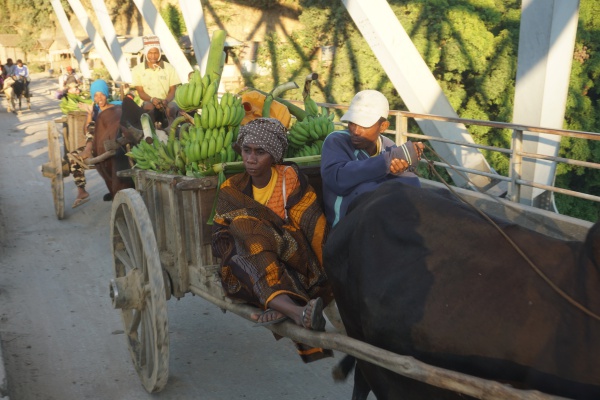
| ||
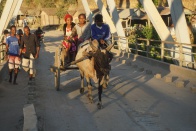
|
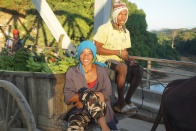
|
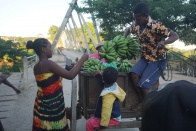
|

|
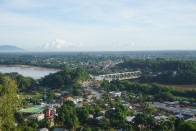
|
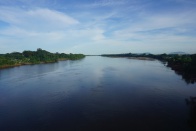
|
The carts are filled with fresh crops brought in from the countryside by farmers who have been on the move since before dawn. They are heading into town to sell their goods at the fruits and vegetables markets.
Zebu carts, Omby Sarety in Malagasy (Aomby in northern dialect), are common sights in and around Ambanja and across the country. These zebu-led carts remain as practical and relevant among farmers today as they have since ancient times.
Dozens of workshops produce carts in Ambanja. One of them is led by Mr Theodore, who, along with his team of six skilled carpenters, manually assembles around 50 carts per year without using motorised power tools.
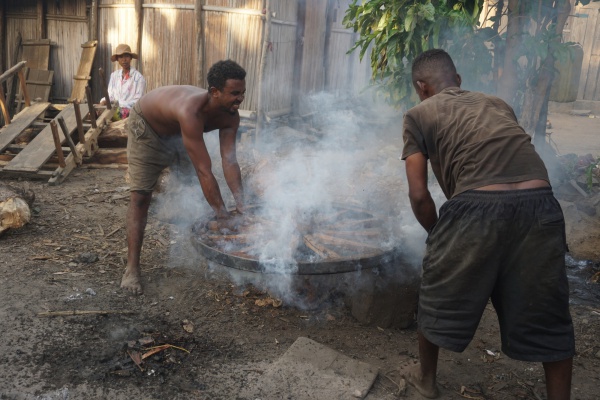
| ||
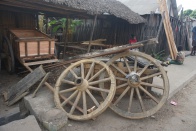
|
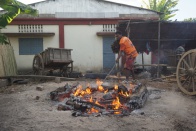
|
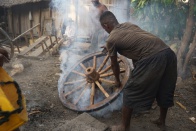
|

|
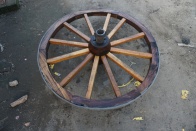
|
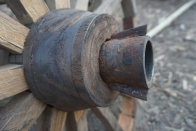
|
The design and model are always the same: A simple two-wheeler that easily attaches to one or more zebus. A cart takes about one week to build and costs 1,800,000 Ariary (about USD 400).
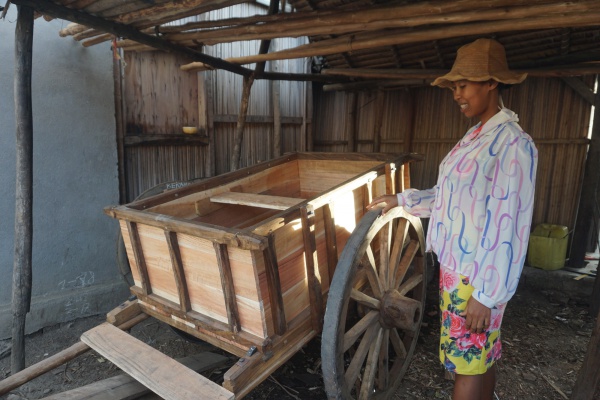
| ||
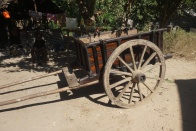
|
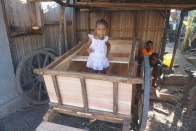
|
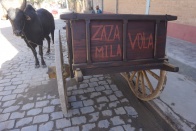
|
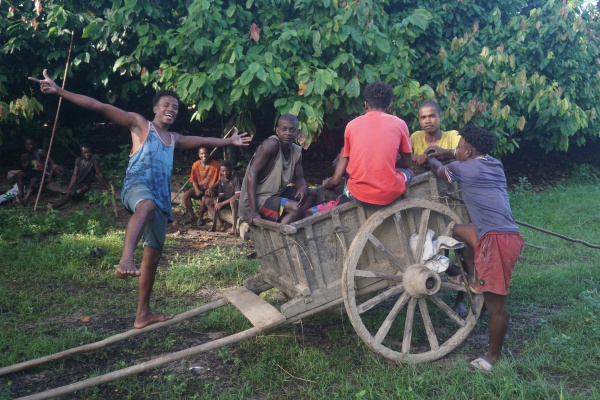
| ||
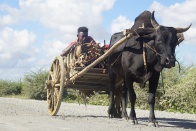
|
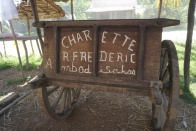
|
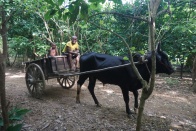
|
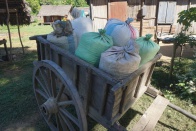
|

|
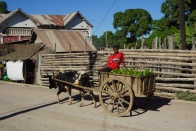
|
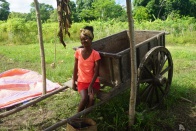
|
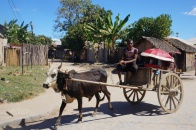
|
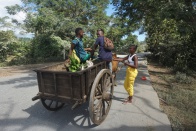
|

| ||
The many Malagasy farmers deserve credit for their traditional and eco-friendly transportation, which by avoiding the use of petrol and diesel-powered vehicles helps keep the air and environment clean and fresh.
Madagascar is a nation of mostly smallholder farmers. One goal of the original organic farming movement was to minimise the use of motorised farming tools, an aspect of agriculture in which Madagascar and its innumerable farmers remain far ahead of every developed nation.
View more Zebu cart photos
Additional information
- Mr. Théodore: 032 49 341 77

